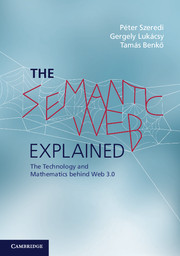4 - Description Logic
Published online by Cambridge University Press: 05 August 2014
Summary
In this chapter we discuss the family of description logic (DL) languages. Following an introduction in Section 4.1, we present informally the most important language elements of Description Logic (Section 4.2). Next, we give the exact syntax and semantics of each language (Sections 4.3–4.5). Section 4.6 gives an overview of reasoning tasks for Description Logic while Section 4.7 deals with the simplification of reasoning tasks. Section 4.8 introduces the so-called assertion boxes (ABoxes). In Section 4.9 we explain the links between Description Logic and first-order logic, while Section 4.10 gives an overview of advanced features of DL languages.
In the present chapter and the rest of the book we follow a common notation: names in DL formulae are typeset using the grotesque font.
Introduction
Description Logic allows us to build a mathematical model describing the notions used in a specific area of interest, or in common knowledge [4]. Description Logic deals with concepts representing sets of individuals: for instance the concept “human” describes the set of all human beings. Furthermore, one can also describe relationships between individuals. In Description Logic, as in RDF, only binary (i.e. two-argument) relationships can be used, which here are referred to as roles. For instance, the role “has child” holds between a parent and a child individual.
- Type
- Chapter
- Information
- The Semantic Web ExplainedThe Technology and Mathematics behind Web 3.0, pp. 175 - 245Publisher: Cambridge University PressPrint publication year: 2014



